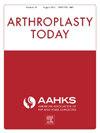Short- and Mid-term Radiographic Outcomes of Ream-then-broaching Metaphyseal Cones During Revision Total Knee Arthroplasty
IF 1.5
Q3 ORTHOPEDICS
引用次数: 0
Abstract
Background
The purpose of this study is to assess the short- and mid-term radiographic outcomes of a ream-then-broach metaphyseal cone design for revision total knee arthroplasty (rTKA).
Methods
A retrospective, multicenter analysis of rTKA patients utilizing femoral and/or tibial metaphyseal cone placement from January 2017 to July 2022 was performed. Assessment of radiolucency was performed utilizing a novel “cones score” for radiolucency for tibial and femoral cones.
Results
Sixty-four rTKAs (23 femoral and 59 tibial cones) with short-term follow-up (12-24 months) and 80 rTKA (24 femoral and 76 tibial cones) with mid-term follow-up (>24 months) were assessed. No intraoperative complications were reported. No cases of cone or stem aseptic loosening were observed. The cones scoring system had a significantly strong intraclass correlation between the 3 reviewers (P < .001). Of tibial cones, 96.6% and 96.1% had no change in cones scoring at short- and mid-term follow-ups, respectively. Of femoral cones, 87.0% and 100% had no change in cones scoring at short- and mid-term follow-ups, respectively. All tibial and femoral implants were deemed radiographically stable at last radiographic follow-up.
Conclusions
The utilization of a ream-then-broach metaphyseal cones demonstrated excellent radiographic stability at short- and mid-term follow-ups. The use of this method has minimal risk of intraoperative or short-term failures. Surgeons should be familiar with this type of cone implantation system.
求助全文
约1分钟内获得全文
求助全文
来源期刊

Arthroplasty Today
Medicine-Surgery
CiteScore
2.90
自引率
0.00%
发文量
258
审稿时长
40 weeks
期刊介绍:
Arthroplasty Today is a companion journal to the Journal of Arthroplasty. The journal Arthroplasty Today brings together the clinical and scientific foundations for joint replacement of the hip and knee in an open-access, online format. Arthroplasty Today solicits manuscripts of the highest quality from all areas of scientific endeavor that relate to joint replacement or the treatment of its complications, including those dealing with patient outcomes, economic and policy issues, prosthetic design, biomechanics, biomaterials, and biologic response to arthroplasty. The journal focuses on case reports. It is the purpose of Arthroplasty Today to present material to practicing orthopaedic surgeons that will keep them abreast of developments in the field, prove useful in the care of patients, and aid in understanding the scientific foundation of this subspecialty area of joint replacement. The international members of the Editorial Board provide a worldwide perspective for the journal''s area of interest. Their participation ensures that each issue of Arthroplasty Today provides the reader with timely, peer-reviewed articles of the highest quality.
 求助内容:
求助内容: 应助结果提醒方式:
应助结果提醒方式:


